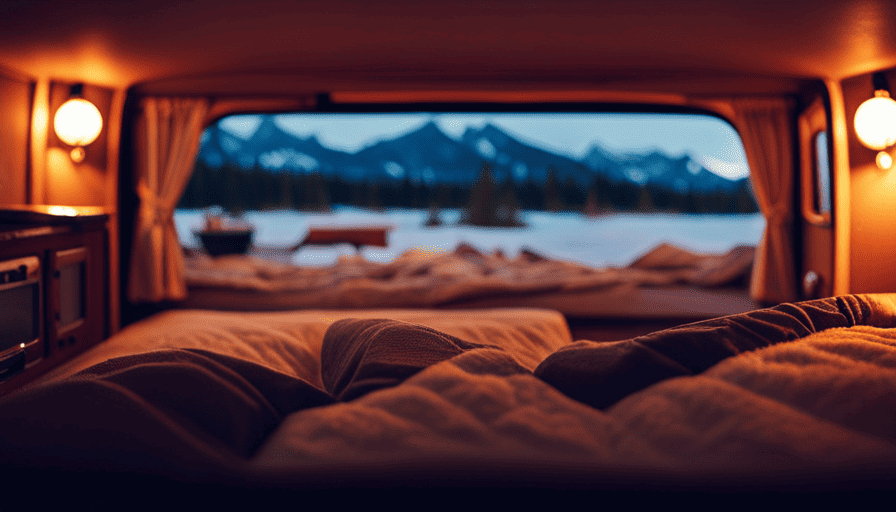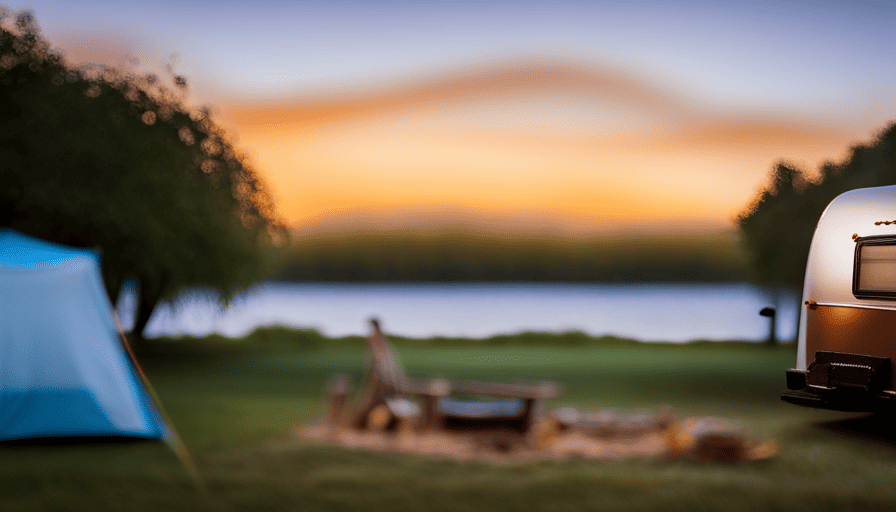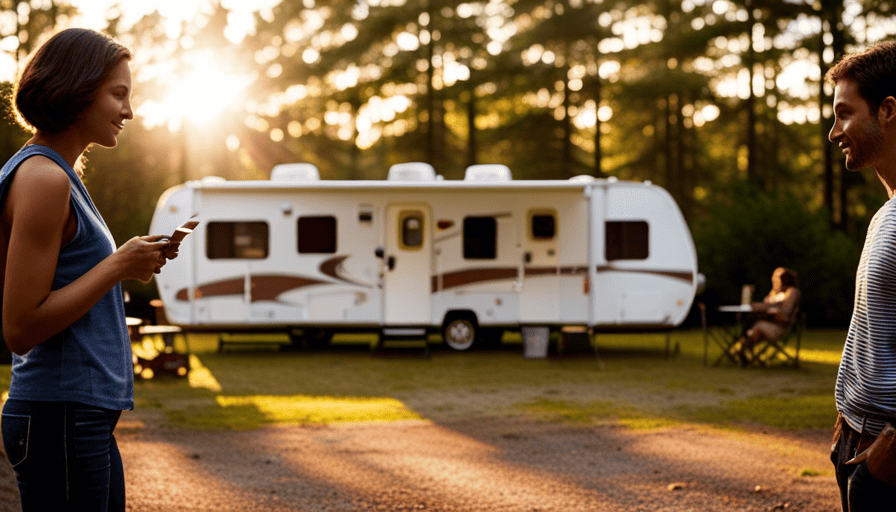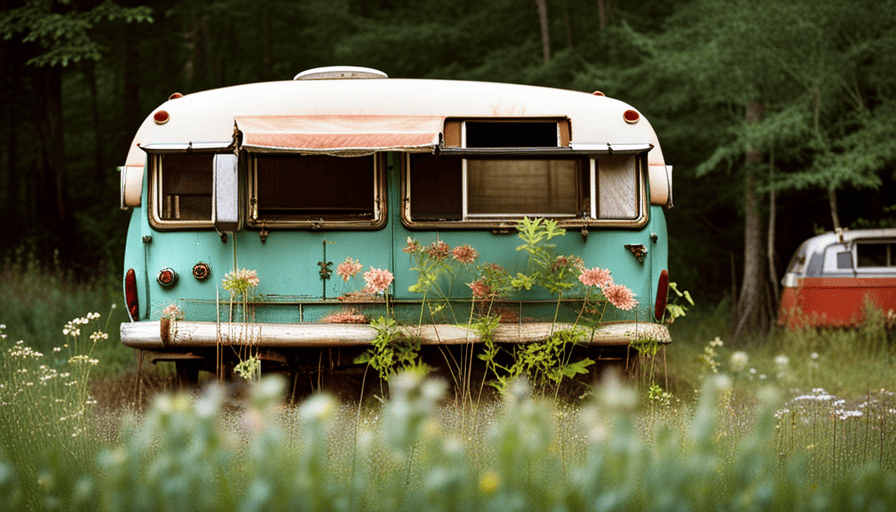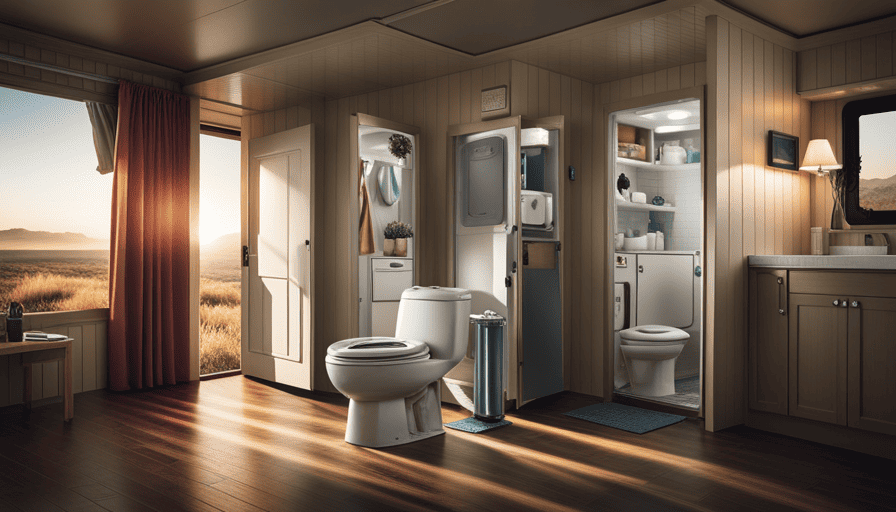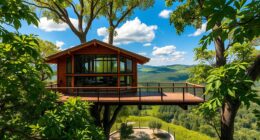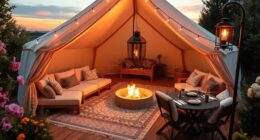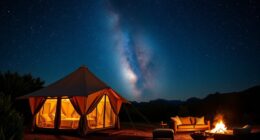Picture yourself nestled in your camper during a cold winter evening, snug and toasty as though enveloped in a soft, fluffy blanket. Warming your camper efficiently is akin to discovering the ideal formula for comfort, guaranteeing your explorations are enjoyable in any climate.
In this article, I will share with you my knowledge and experience on how to heat a camper, so you can stay warm and snug during your travels. From understanding your heating options to insulating your camper, I will guide you through various methods that will keep the cold at bay.
We will explore the use of portable electric heaters and portable propane heaters, as well as the option of a wood-burning stove. Additionally, I will provide tips on using insulated bedding and blankets, sealing doors and windows, and utilizing heat-reflective materials.
Lastly, I will emphasize the importance of good ventilation to maintain a healthy and comfortable living environment inside your camper. So, let’s dive in and discover the secrets to keeping your camper warm and inviting, no matter the outside temperature.
Key Takeaways
- Consider the different heating options available for campers, such as propane heaters, electric heaters, and wood-burning stoves.
- Implement insulation techniques like foam board or fiberglass insulation for walls and ceiling, weatherstripping and thermal curtains for windows and doors, and thermal underlay or carpeting for the floor.
- When choosing a portable electric heater, consider options like ceramic heaters or oil-filled radiators, which offer energy efficiency, quick heating time, and consistent heat distribution.
- Take safety precautions when using heaters, such as keeping flammable items away, never leaving them unattended, and installing carbon monoxide detectors to prevent CO poisoning.
Understand Your Heating Options
So, now that you’ve parked your camper in the great outdoors, let’s dive into the many ways you can cozy up and stay warm!
When it comes to heating systems for campers, there are several options to consider. One popular choice is a propane heater, which is efficient and provides a consistent source of heat. These heaters use propane gas to generate warmth, making them ideal for boondocking or dry camping.
Another option is an electric heater, which can be plugged into an electric hookup at a campground. Electric heaters are convenient and easy to use, but keep in mind that they require a power source. To maximize energy efficiency, look for heaters with adjustable thermostats and programmable timers.
Additionally, consider investing in a portable ceramic heater, which is compact and can be easily moved around your camper.
Now that you understand your heating options, let’s explore how to insulate your camper and keep the warmth inside.
Insulate Your Camper
To keep your home-on-wheels cozy during chilly adventures, it’s essential to ensure your mobile abode is well-insulated. Proper insulation techniques are crucial for maintaining a comfortable temperature inside your camper.
By insulating your camper, you can prevent heat loss and keep the cold air from seeping in. There are various energy efficient solutions available that can help you achieve optimal insulation.
One effective technique is to insulate the walls and ceiling of your camper. You can use materials like foam board insulation or fiberglass insulation to create a barrier against the outside elements. Additionally, insulating your windows and doors can further minimize heat loss. Weatherstripping and thermal curtains are great options for preventing drafts and retaining heat.
Another important aspect to consider is insulating the floor of your camper. This can be done by using thermal underlay or insulating carpeting. By insulating the floor, you can prevent cold air from coming up through the ground and keep your feet warm.
By incorporating these insulation techniques, you can create a more energy efficient and comfortable living space in your camper. With proper insulation, you can now move on to the next step in heating your camper – using portable electric heaters. These heaters are a convenient and effective way to warm up your space without relying solely on your RV’s built-in heating system.
Use Portable Electric Heaters
When it comes to heating my camper, I’ve found that portable electric heaters are a great option. One type of heater that I’ve had success with is a ceramic heater. These heaters are compact, efficient, and provide instant heat.
Another option is an oil-filled radiator, which is a bit larger but offers a more consistent and long-lasting heat.
And let’s not forget about electric blankets, which are perfect for keeping warm while sleeping.
Overall, these portable electric heaters are essential for keeping my camper cozy and comfortable during those chilly nights.
Ceramic heaters
Imagine the cozy warmth that a ceramic heater can bring to your camper on those chilly nights. Ceramic heaters are a popular choice for heating campers due to their safety features and numerous benefits. Here are a few reasons why ceramic heaters are a great option:
-
They’re energy-efficient, using less energy compared to other types of heaters, making them cost-effective.
-
They have a quick heating time, so you can warm up your camper in no time.
-
They’re equipped with safety features such as tip-over shut off and overheat protection, ensuring peace of mind.
-
They’re portable, lightweight, and compact, making them easy to move around and store.
Now, let’s explore the next section about oil-filled radiators to further enhance the warmth and comfort in your camper.
Oil-filled radiators
Enhance the cozy atmosphere in your camper with the gentle warmth of an oil-filled radiator. Oil-filled radiators are a popular option for heating campers because they provide a consistent and efficient heat source. These radiators work by heating up the oil inside them, which then radiates heat into the room. This method ensures that the heat is distributed evenly, creating a comfortable environment.
Oil-filled radiators are also safe to use in enclosed spaces, as they don’t produce any fumes or emissions. Additionally, they’re easy to operate, with adjustable temperature settings and timers for convenience. When considering electric heating options for your camper, oil-filled radiators are a reliable choice.
Transitioning into the subsequent section about electric blankets, you can further enhance your camper’s coziness with another heating option.
Electric blankets
To add an extra layer of warmth and comfort, electric blankets are an excellent choice for your cozy camper. Electric blankets are designed to provide targeted heat and can be easily adjusted to your desired temperature. They’re energy-efficient, consuming minimal electricity while keeping you warm throughout the night.
The blankets are equipped with safety features such as automatic shut-off timers and overheat protection, ensuring a worry-free and cozy sleep. Additionally, electric blankets are lightweight and portable, making them convenient for camping trips.
However, while electric blankets are great for keeping you warm while sleeping, they may not provide sufficient heat for the entire camper. To fully heat your camper, it’s recommended to invest in a portable propane heater, which can effectively warm up the entire space.
Invest in a Portable Propane Heater
When it comes to heating my camper, I always choose a safe and efficient portable propane heater. It’s important to select a model that’s specifically designed for indoor use and has safety features such as an automatic shut-off.
Additionally, I make sure to follow proper ventilation guidelines to prevent any build-up of carbon monoxide. Finally, I always use carbon monoxide detectors to provide an extra layer of safety and peace of mind.
Choose a safe and efficient model
Opt for a reliable and energy-efficient model to ensure safe heating in your camper. When choosing a propane heater, it’s important to prioritize safety and efficiency. Here are four key factors to consider:
-
Safety features: Look for models with built-in safety features such as automatic shut-off valves and tip-over protection to prevent accidents and ensure peace of mind.
-
Energy efficiency: Opt for heaters that have high energy efficiency ratings, as this will not only save you money on fuel costs but also reduce your carbon footprint.
-
Size and portability: Consider the size and weight of the heater, especially if you have limited space in your camper. Portable models are easy to move around and can be stored away when not in use.
-
User-friendly controls: Choose a heater with easy-to-use controls and a clear display, so you can adjust the temperature and settings effortlessly.
By selecting a safe and efficient propane heater, you can enjoy cozy warmth in your camper without compromising on safety. However, it’s crucial to also follow proper ventilation guidelines to ensure the well-being of everyone inside.
Follow proper ventilation guidelines
When it comes to heating a camper, choosing a safe and efficient model is crucial. However, it’s not just about the heater you choose, but also how you use it. Proper ventilation is essential to ensure safety and prevent the buildup of harmful gases.
When using a heater in a camper, it’s important to follow proper ventilation guidelines to ensure the air quality remains at a safe level. This means opening windows or vents to allow fresh air to circulate and removing any obstacles that may block airflow. Additionally, it’s important to take safety precautions such as keeping flammable items away from the heater and never leaving it unattended.
By following these guidelines, you can safely and effectively heat your camper.
Now let’s discuss the importance of using carbon monoxide detectors.
Use carbon monoxide detectors
Make sure to use carbon monoxide detectors to ensure the safety of your indoor environment. Carbon monoxide (CO) is a colorless, odorless gas that can be deadly when inhaled in high concentrations. It is produced by incomplete combustion of fuel, making it a potential threat in any enclosed space, including campers. To prevent CO poisoning, it is crucial to have reliable detectors installed. Apart from using carbon monoxide detectors, it is also important to consider heat source alternatives that do not produce CO, such as electric heaters or propane heaters with proper ventilation. Common carbon monoxide sources in campers include gas-powered generators, propane stoves, and charcoal grills. By being aware of these sources and taking necessary precautions, you can enjoy a warm and cozy camper without compromising your safety. Speaking of alternative heat sources, consider a wood-burning stove for efficient and sustainable heating.
Consider a Wood-Burning Stove
If you’re feeling nostalgic for a cozy cabin in the woods, why not consider adding a wood-burning stove to your camper? Not only can it provide warmth and comfort during those chilly nights, but it also adds a touch of rustic charm to your mobile home.
Wood burning stove installation in a camper may seem daunting, but with the right tools and knowledge, it can be a rewarding project.
One of the key benefits of using a wood-burning stove in a camper is its efficiency. Unlike propane or electric heaters, a wood stove can keep you warm for hours on end without using up too much fuel. Plus, wood is often more readily available and cost-effective compared to other heating options.
Additionally, the dry heat produced by a wood stove can help to reduce moisture and condensation inside your camper, preventing mold and mildew growth.
When installing a wood-burning stove, it’s important to consider safety measures. Make sure to follow all manufacturer’s instructions and consult with a professional if needed. You’ll also need to ensure proper ventilation to avoid the risk of carbon monoxide build-up. Installing a chimney or venting system is crucial for the safe operation of your wood stove.
A wood-burning stove can be a fantastic addition to your camper, providing warmth, ambiance, and cost-effectiveness. However, if you’re looking for a more portable heating solution, utilizing space heaters might be a better option.
Utilize Space Heaters
After considering the option of a wood-burning stove for heating my camper, I realized that it may not be the most practical choice for me. As much as I love the idea of a cozy fire and the rustic ambiance it brings, the maintenance and safety concerns associated with wood-burning stoves made me look for alternative solutions.
That’s when I came across the idea of utilizing portable space heaters. Portable space heaters are a convenient and effective way to heat a camper. They come in various sizes and designs, allowing you to choose the one that best fits your space. When selecting a space heater, it’s important to look for energy-efficient options that won’t drain your camper’s power supply. Many modern space heaters are equipped with energy-saving features such as programmable timers and adjustable thermostats, helping to conserve energy and reduce costs.
One key advantage of portable space heaters is their versatility. You can easily move them around to different areas of your camper, ensuring that you stay warm wherever you are. However, it’s important to use them safely by following the manufacturer’s instructions and keeping them away from flammable materials.
As I transition into the next section about using insulated bedding and blankets, it’s important to remember that space heaters alone may not provide sufficient warmth during colder nights. By combining the use of portable space heaters with insulated bedding and blankets, you can create a cozy and comfortable sleeping environment in your camper.
Use Insulated Bedding and Blankets
Utilizing insulated bedding and blankets can enhance the coziness of your sleeping environment in the camper. When it comes to staying warm during those chilly nights on the road, having the right bedding can make all the difference. Insulated mattress pads are a great investment as they not only provide extra cushioning but also help to trap heat and keep you warm throughout the night. These pads are typically made with materials that have excellent insulation properties, such as foam or down, and can significantly improve the overall comfort of your sleeping experience.
Another option to consider is thermal sleeping bags. These bags are specially designed to provide optimal insulation and retain body heat. They are typically made with materials that have excellent heat retention properties, such as synthetic fibers or down. Thermal sleeping bags come in various sizes and temperatures ratings, allowing you to choose one that best suits your needs.
To help you visualize the benefits of insulated bedding and blankets, take a look at the table below:
| Benefits of Insulated Bedding and Blankets |
|---|
| Improved heat retention |
| Enhanced comfort and coziness |
| Protects against cold drafts |
| Provides additional cushioning |
| Lightweight and easy to pack |
Now that you have your bedding sorted, let’s move on to the next step: keeping the doors and windows sealed to prevent heat loss.
Keep Doors and Windows Sealed
Now that we’ve talked about using insulated bedding and blankets to stay warm in your camper, let’s move on to another important aspect of heating – keeping doors and windows sealed.
Proper weatherstripping is crucial in preventing drafts and heat loss in your camper. It helps to create a tight seal around doors and windows, making it more energy efficient and keeping the warm air inside.
One effective way to seal your windows is by using window insulation film. This transparent film is applied directly to the glass and works by creating an additional layer of insulation. It helps to reduce heat transfer through the windows and keeps the cold air out. Window insulation film is easy to install and can make a significant difference in the overall warmth of your camper.
By keeping your doors and windows properly sealed, you can minimize heat loss and make your camper more comfortable during colder weather.
Now that we’ve covered the importance of sealing, let’s move on to the next step – using heat-reflective materials. These materials can help to maximize the heat generated in your camper and ensure that it stays warm and cozy.
Use Heat-Reflective Materials
To make your living space more cozy, try using heat-reflective materials that’ll help maximize the warmth and keep you comfortable throughout the colder weather.
One option is to apply heat reflective paint to the interior walls of your camper. This type of paint contains special additives that reflect heat back into the room, preventing it from escaping through the walls. By creating a barrier that traps the warmth inside, heat reflective paint can significantly improve the overall temperature of your camper.
Another way to utilize heat-reflective materials is by using reflective window coverings. These coverings are designed to reflect the sun’s rays away from your camper during the summer, and during the winter, they can help retain the heat inside. They work by reducing heat transfer through the windows, preventing the cold air from seeping in and the warm air from escaping.
By incorporating heat-reflective materials like paint and window coverings, you can effectively enhance the insulation of your camper, making it more comfortable and energy-efficient. These materials work together to create a warmer environment, allowing you to enjoy your camping experience even in chilly temperatures.
When it comes to heating your camper, it’s important to practice good ventilation to ensure the safety and well-being of everyone inside.
Practice Good Ventilation
One key to keeping your living space comfortable during colder weather is ensuring good ventilation. Proper ventilation not only helps to circulate fresh air but also prevents condensation and mold growth. Here are three important ventilation benefits to consider:
-
Improved air quality: Good ventilation helps to remove stale air and pollutants from inside the camper. This ensures that you’re breathing in clean and fresh air, which is essential for your health and well-being.
-
Moisture control: During colder months, condensation can build up inside the camper, leading to dampness and mold growth. By practicing good ventilation, you can reduce the amount of moisture in the air, preventing these issues and maintaining a dry living space.
-
Temperature regulation: Ventilation plays a crucial role in regulating the temperature inside your camper. By allowing fresh air to enter and circulate, you can prevent the buildup of heat and humidity, keeping the interior cool and comfortable.
To achieve effective ventilation, there are a few tips to keep in mind. Firstly, make sure to open windows and vents regularly to allow fresh air to come in. Secondly, consider using a rooftop vent or fan to increase airflow. Lastly, avoid blocking vents or air passages with furniture or other objects.
By practicing good ventilation, you can create a more comfortable and healthy environment inside your camper during colder weather.
Frequently Asked Questions
How much does it cost to install a wood-burning stove in a camper?
Installing a wood-burning stove in a camper can range in cost depending on factors like the size of the stove and the complexity of the installation. For example, I recently helped a friend install a wood-burning stove in their camper for around $500.
The benefits of using a wood-burning stove in a camper are numerous. It provides a reliable source of heat, allows for cooking, and creates a cozy ambiance.
Can I use a portable electric heater while driving my camper?
Yes, you can use a portable electric heater while driving your camper. However, it’s essential to prioritize safety when using any heating device in a moving vehicle. Ensure that the heater is securely placed and doesn’t obstruct any vents or other important components. Additionally, it’s always a good idea to have alternative heating options for campers, such as propane heaters or a wood-burning stove, in case of power outages or other unforeseen circumstances.
Are there any safety concerns when using a portable propane heater inside a camper?
Safety concerns should not be taken lightly when using a portable propane heater inside a camper. Precautions are essential to prevent potential accidents. Propane heaters emit carbon monoxide, which is a silent killer. Therefore, proper ventilation is crucial to ensure the gas is safely expelled.
Additionally, it’s important to have a working carbon monoxide detector inside the camper. Always follow the manufacturer’s instructions, maintain the heater regularly, and never leave it unattended.
What are the best types of insulated bedding and blankets for keeping warm in a camper?
For keeping warm in a camper, there are a few fantastic options for insulated bedding and blankets. One essential item is an insulated mattress, which helps to retain body heat and prevent cold air from seeping in.
Additionally, an electric heated blanket is a great investment as it provides instant warmth and can be adjusted to the desired temperature.
These two items combined create a cozy and comfortable sleeping environment, even in the coldest camping conditions.
How can I effectively seal off any gaps or cracks around my camper’s doors and windows for better insulation?
Oh boy, let me tell you about sealing off those pesky gaps and cracks around your camper’s doors and windows! It’s like playing a game of hide and seek with the cold weather. But fear not, my friend, I’ve got some sealing techniques up my sleeve that’ll make those drafts run for cover.
Weatherstripping options like adhesive foam tape or rubber gaskets can work wonders in keeping the cold out and the warmth in. So say goodbye to chilly nights and hello to cozy camping!
Is the Method of Heating a Camper in Winter Different from Regular Heating?
Is the method of heating a camper in winter different from regular heating? When it comes to heating options for winter camping, there are some differences to consider. While regular heating systems rely on the infrastructure of a building, heating a camper in winter requires portable and efficient solutions. This may involve using propane heaters, electric heaters, or even specialized wood-burning stoves designed for campers. Having reliable heating options is crucial for staying warm and comfortable during winter camping adventures.
Conclusion
In conclusion, keeping your camper warm and cozy during those chilly nights is essential for a comfortable camping experience. By understanding your heating options and implementing proper insulation, you can ensure that the warmth stays inside.
Investing in portable electric heaters or propane heaters can provide efficient heat, while a wood-burning stove adds a rustic charm. Don’t forget to use insulated bedding and blankets for added coziness.
Remember, a well-sealed camper with heat-reflective materials and good ventilation will make your camping adventures even more enjoyable. So go ahead, embrace the warmth and create unforgettable memories in the great outdoors.

